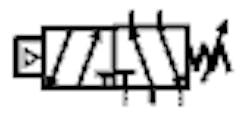Quiz on Chapter 14: Sequence Valves and Reducing Valves
1. An air line regulator is:
- normally open
- normally closed
- normally neutral
2. An air sequence valve is usually a:
- pilot-operated 3-way valve
- pilot-operated 4-way valve
- pilot-operated 5-way valve
3. Hydraulic sequence valves are normally used in conjunction with:
- multi-cylinder circuits with flow control valves
- multi-cylinder circuits and a single directional control valve
- multi-cylinder circuits in place of a relief valve
4. Hydraulic kick-down sequence valves :
- open at set pressure and maintain inlet pressure
- open at set pressure and drop inlet pressure to outlet port pressure
- close at set pressure
5. Internally piloted counterbalance valves’ main advantage is:
- jerky action as the load is lowered
- they never need to be re-adjusted at load change
- smooth, controlled extend action of the load
6. Externally piloted counterbalance valves:
- drop all backpressure at load contact
- must be adjusted for load changes
- have very smooth and controlled action during extension
7. Hydraulic reducing valves maintain pressure by:
- opening when reaching set pressure
- closing when reaching set pressure
- sending fluid to tank at set pressure
8. Hydraulic reducing valves:
- never need a bypass check valve
- always need a bypass check valve
- need a bypass check valve when flow must be reversed
9. Hydraulic reducing relieving valves:
- send pump flow to tank just above set pressure
- send actuator flow to tank at pressure just above set pressure
- never send any system flow to tank
10. This symbol is for a:
- sequence valve
- counterbalance valve .
- reducing valve


